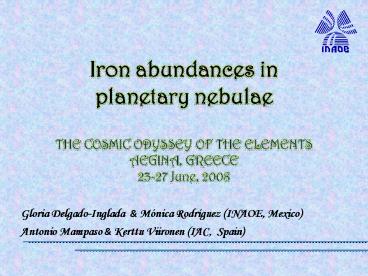Composicin qumica y polvo en nebulosas planetarias - PowerPoint PPT Presentation
1 / 13
Title:
Composicin qumica y polvo en nebulosas planetarias
Description:
We can compare the results with those found in H II regions. ... High depletion factors in both PNe and H II regions argue for: ... – PowerPoint PPT presentation
Number of Views:23
Avg rating:3.0/5.0
Title: Composicin qumica y polvo en nebulosas planetarias
1
(No Transcript)
2
1. Introduction
- AGB stars are the most efficient sources of
circumstellar dust (Whittet 2003). - It is not clear how much dust do PNe have and
whether this dust is destroyed or modified
(Pottasch et al. 1984, Lenzuni et al. 1989,
Stasinska Szczerba 1999). - Studying dust through element depletions? IRON
- - mostly condensed into dust grains
- - relatively high cosmic abundance
- - lines in the optical range
3
1. Introduction
- Fe abundances in PNe calculated using different
ions, different corrections, and different atomic
data.
References for Fe abundances in Galactic PNe
Shields (1975), Garstang et al. (1978) Shields
(1978) Clegg et al. 1987a, 1987b Middlemass
(1990) Perinotto et al. (1999) Pottasch
Beintema (1999) Pottasch et al. 2001 Pottasch
et al. 2002, 2003 Liu et al. 2004 Pottasch
Surendiranath 2005 Sterling et al. 2005
Georgiev et al. (2006) Pottasch Surrendiranath
2007 Pottasch et al. 2007, 2008
The derived values of Fe/H go from 1/4 to
1/300 of the solar value
- A homogeneous study of Fe depletion factors in
PNe would be valuable. - We can compare the results with those found in H
II regions.
4
2. The Fe IV discrepancy
- In H II regions
- Fe is often negligible.
- Fe IV lines are weaker than Fe III lines.
- ? Fe abundance from Fe and ICF from
models. - Discrepancy between Fe/H (Fe/H) ICF
- Fe/H Fe/H Fe3/H
5
2. The Fe IV discrepancy
Rodríguez Rubin (2005)?
? Errors in the collision strengths of Fe3 by a
factor of 2-3?
ICF 1
(based on photoionization models)?
? Errors in the collision strengths of Fe by a
factor of 2-3 ?
ICF 1 ? - 0.3 dex
? Errors in the total recombination coefficient
or the rate of charge-exchange reaction with H0
for Fe3 by a factor of 10?
or
ICF 2
(derived from objects with Fe IV lines)?
(when log (O/O) -0.1)?
6
2. The Fe IV discrepancy
Rodríguez Rubin (2005)?
Since the discrepancy is probably due to some
combination of the aforementioned causes, the
errors required in any of the atomic data are
likely to be lower than those considered before,
and hence, the value of the Fe abundance will
probably be intermediate between the extreme
values obtained with the three ICFs we can
constrain the real value of the Fe abundance with
the values obtained from the three ICFs.
7
3. THE SAMPLE AND THE ANALYSIS
Selection criteria I(HeII ?4686)/I(Hß)
0.3 ne 25000 cm-3 28 low-ionization Galactic
PNe ? 5 PNe were observed in the 2.1m
telescope at Observatorio Astronómico Nacional,
San Pedro Martir, Mexico. ? 23 PNe from the
literature.
REFERENCES Line intensities of the PNe from
Wesson et al. (2005), Sharpee et al. (2003), Liu
et al. (2004), Tsamis et al. (2003), Hyung et
al. (2001a), Hyung et al. (2001b), Liu et al.
(2000), Wesson Liu (2004).
8
3. THE SAMPLE AND THE ANALYSIS
Physical conditions neS II, neCl III, neAr
IV ? ne TeN II, TeO III Ionic
abundances O/H, O/H, Fe/H,
Fe/H Total abundances O/H (O/H
O/H ) ICF (O) Fe/H O/H
(Fe/O) ICF(Fe)? from Kingsburgh
Barlow (1994)?
O/H and O/H using IRAF Fe/H
Emissivities from Bautista Pradhan
(1996)? Fe/H CS from Zhang (1996), TP from
Quinet (1996)?
? We compare with a group of 10 H II regions.
REFERENCES Ionic abundances of the H II regions
from García-Rojas et al. (2007), García-Rojas
et al. (2006), Esteban et al. (2004), Rodríguez
(2002), García-Rojas et al. (2004), García-Rojas
et al. (2005).
9
4. RESULTS
WITH ICF 1
Delgado-Inglada et al. (2008, in prep.)?
10
4. RESULTS
WITH ICF 1
- 0.3 dex
Delgado-Inglada et al. (2008, in prep.)?
11
4. RESULTS
WITH ICF 2 or
Delgado-Inglada et al. (2008, in prep.)?
12
4. RESULTS AND CONCLUSIONS
? Fe/H log (Fe/H) log (Fe/H) from -3.4 to
-1.0 dex ? more than 90 of Fe atoms are
condensed into dust grains. ?The solar value of
Fe/H will not be suitable as a reference value
for ? PNe with H-poor central stars (where iron
depletion due to the s-process could be
important) ? we do not find a systematic
difference between the Fe abundances in PNe with
H-poor and H-rich central stars (see also
Sterling Dinerstein 2008). ? PNe in which
the progenitors stars have been formed in a
lower metallicity medium ? at least 80 of Fe
condensed in dust.
?
12 log (Fe/H) 7.540.05 (Lodders 2003)
?
13
4. RESULTS AND CONCLUSIONS
? Considering 90 of Fe in dust ? Mdust/Mgas
1.310-3 ? No correlation with the Hß surface
brightness ? Our sample is relatively young
(Pottasch et al. 1984 and Lenzuni et al. 1989
concluded that the dust is destroyed during the
lifetime of the PNe, Stasinska Szczerba 1999
did not find evidence for destruction). ? High
depletion factors in both PNe and H II regions
argue for - high efficiency of depletion onto
dust grains and - low efficiency of destruction
mechanisms in both environments.































